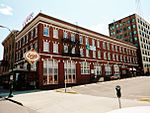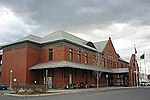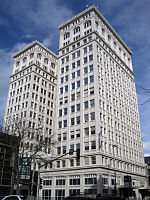Spokane Club Building-Legion Building
Buildings and structures completed in 1901National Register of Historic Places in Spokane County, WashingtonRenaissance Revival architecture in Washington (state)Washington (state) Registered Historic Place stubs

The Spokane Club Building-Legion Building is a historic five-story building in Spokane, Washington. It was designed by architect John K. Dow in the Renaissance Revival style, and built by Peter Peterson in 1901 for businessman F. Lewis Clark, the founder of the Spokane Club. It has been listed on the National Register of Historic Places since August 8, 1994.
Excerpt from the Wikipedia article Spokane Club Building-Legion Building (License: CC BY-SA 3.0, Authors, Images).Spokane Club Building-Legion Building
North Bernard-Washington Alley, Spokane
Geographical coordinates (GPS) Address Nearby Places Show on map
Geographical coordinates (GPS)
| Latitude | Longitude |
|---|---|
| N 47.658333333333 ° | E -117.41666666667 ° |
Address
North Bernard-Washington Alley
North Bernard-Washington Alley
99201 Spokane
Washington, United States
Open on Google Maps








